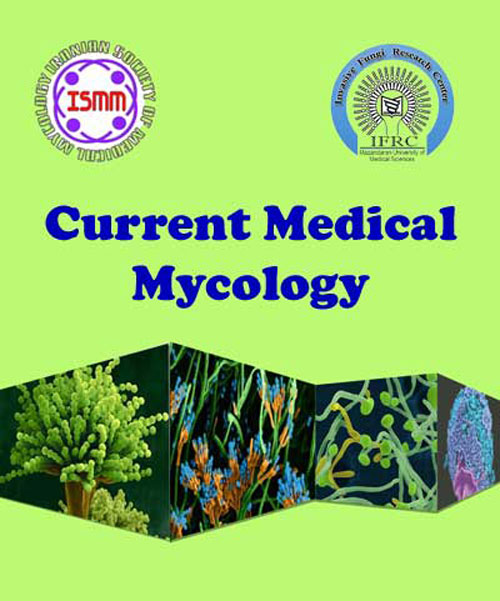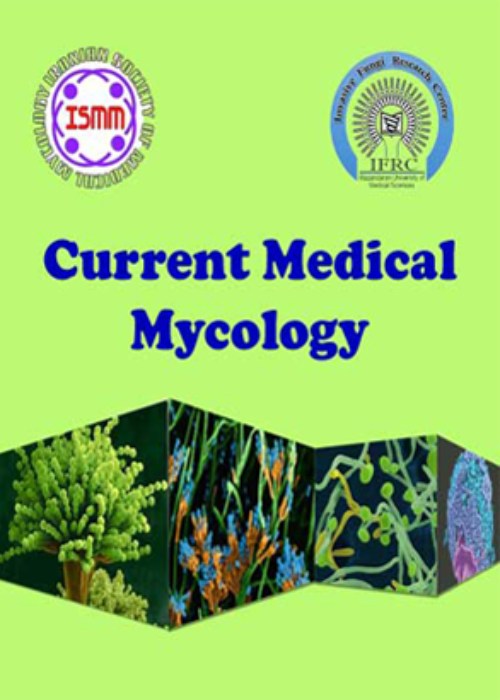فهرست مطالب

Current Medical Mycology
Volume:1 Issue: 4, Dec 2015
- تاریخ انتشار: 1395/05/07
- تعداد عناوین: 8
-
-
Pages 1-6Background andPurposeTinea capitis and tinea unguium are regarded as global public health concerns. The purpose of the present study was to identify the etiological agents of tinea capitis and tinea unguium in patients, referring to the Central Laboratory of Yazd University of Medical Sciences, Yazd, Iran.Materials And MethodsThis study was conducted during 2014-2015. Skin scraping, scalp hair, and nail clipping specimens were collected from 134 patients (80 males and 54 females) with clinical features suggesting fungal involvement. Direct microscopic examinations were carried out, using potassium hydroxide 10%, while culture studies were performed on Sabouraud dextrose agar, containing chloramphenicol and cycloheximide at 28°C for four weeks. Fungal colonies were identified based on their macroscopic and microscopic characteristics, as well as supplementary diagnostic tests.ResultsAmong 134 patients, 12 cases showed positive results on direct examination and culture studies. The frequency of infections was equal among male and female subjects. Among 12 affected cases, the frequency of tinea capitis and tinea unguium was 91.6% and 8.4%, respectively. Microsporum canis (50%) was the most prevalent species, followed by Trichophyton verrucosum (25%) and Trichophyton mentagrophytes (25%). Also, tinea unguium, caused by T. mentagrophytes, was found in a female patient.ConclusionThe etiological agents of scalp and nail dermatophytosis have changed in Yazd over the past 13 years. In the present study, replacement of anthropophilic dermatophytes by zoophilic species was noteworthy, highlighting the necessity of efficient surveillance for the management and prevention of infections.Keywords: Dermatophytes, Iran, Onychomycosis, Tinea capitis
-
Pages 7-12Background andPurposeCandida species are the most common organisms involved in superficial fungal infections, worldwide. Although econazole is among the most frequently used topical formulations for the treatment of candidiasis, no information is available regarding the susceptibility profiles of Candida species in Iran.Materials And MethodsIn vitro susceptibility of 100 clinical Candida isolates belonging to 6 species from superficial candidiasis of Iran towards to econazole was compared with three other common antifungal agents including itraconazole, fluconazole, and miconazole. Minimum inhibitory concentrations (MICs) values were analyzed according to the Clinical and Laboratory Standards Institute (CLSI) M38-A3 document. All isolates were previously identified to the species level, using polymerase chain reaction-restriction fragment length polymorphism (PCR-RFLP) on ITS region.ResultsThe MIC of econazole, itraconazole, miconazole, and fluconazole were within the range of 0.016-16, 0.032-16, 0.016-16, and 0.25-64 AWT IMAGEg/ml, respectively. In general, econazole and miconazole were more active against Candida isolates, compared to the other two agents.ConclusionThe present study demonstrated that for Candida albicans isolates, miconazole and econazole had the best effect, but in non-albicans Candida species, itraconazole and miconazole displayed more activity than other antifungal agents.Keywords: Antifungal susceptibility, Econazole, Superficial candidiasis
-
Pages 13-19Background andPurposeEssential oils extracted from different plants are extensively used in perfume, beverage, and food industries and are reported to exhibit antimicrobial activities against a variety of fungi. Zhumeria majdae belonging to the Lamiaceae family is a rare and endemic medicinal plant species in Iran, with a strong and pleasant odor. The leaves of this plant have been used for many years as an antiseptic carminative agent for the treatment of stomachache (especially in infants) and dysmenorrhea.Materials And MethodsGas chromatography/mass spectrometry (GC/MS) analysis was performed to determine the main constituents of the essential oil extracted from the aerial parts of Z. majdae. Also, the minimum inhibitory concentrations (MICs) were determined, using serial dilution method.ResultsBased on the GC/MS analysis, 31 compounds representing 95.36% of the essential oil, extracted from the aerial parts of the plant, were identified, among which linalool (63.40%) and camphor (27.48%) were recognized as the major constituents. The total phenolic content was 42.74 GAE (mg)/DW (g). The hydro-distilled essential oil from the aerial part of the plant displayed potential antifungal activities against all the tested pathogenic fungal species (i.e., Candida albicans, Trichophyton mentagrophytes, Aspergillus flavus, Trichophyton rubrum, Microsporum canis, Microsporum gypseum, and Epidermophyton floccosum). Based on the inhibition zone (29 mm) and MIC value (0.015 AWT IMAGEl/ml), all the tested strains were sensitive to Z. majdae essential oil.ConclusionThe present results support the traditional and possible use of Z. majdae essential oil in food, pharmaceutical, and cosmetic industries.Background andPurposeEssential oils extracted from different plants are extensively used in perfume, beverage, and food industries and are reported to exhibit antimicrobial activities against a variety of fungi. Zhumeria majdae belonging to the Lamiaceae family is a rare and endemic medicinal plant species in Iran, with a strong and pleasant odor. The leaves of this plant have been used for many years as an antiseptic carminative agent for the treatment of stomachache (especially in infants) and dysmenorrhea.Materials And MethodsGas chromatography/mass spectrometry (GC/MS) analysis was performed to determine the main constituents of the essential oil extracted from the aerial parts of Z. majdae. Also, the minimum inhibitory concentrations (MICs) were determined, using serial dilution method.ResultsBased on the GC/MS analysis, 31 compounds representing 95.36% of the essential oil, extracted from the aerial parts of the plant, were identified, among which linalool (63.40%) and camphor (27.48%) were recognized as the major constituents. The total phenolic content was 42.74 GAE (mg)/DW (g). The hydro-distilled essential oil from the aerial part of the plant displayed potential antifungal activities against all the tested pathogenic fungal species (i.e., Candida albicans, Trichophyton mentagrophytes, Aspergillus flavus, Trichophyton rubrum, Microsporum canis, Microsporum gypseum, and Epidermophyton floccosum). Based on the inhibition zone (29 mm) and MIC value (0.015 AWT IMAGEl/ml), all the tested strains were sensitive to Z. majdae essential oil.ConclusionThe present results support the traditional and possible use of Z. majdae essential oil in food, pharmaceutical, and cosmetic industries.Keywords: Antifungal activity, Chemical composition, Minimum inhibitory concentration, Total phenolic content, Zhumeria majdae
-
Pages 20-25Background andPurposeDermatophytosis is one of the most common infections of skin, hair, and nails, caused by a group of keratinophilic fungi known as dermatophytes. Species identification of these fungi is of great significance from epidemiological and therapeutic points of view. The objective of the present study was to investigate dermatophytosis and its causative agents in patients, referring to the Central Mycology Laboratory of Yazd University of Medical Sciences, Yazd, Iran.Materials And MethodsIn total, 139 clinically suspected cases of dermatophytosis were examined during 12 months from February 2014 to February 2015. Skin scrapings were assessed through direct microscopic examinations and culture studies. Dermatophyte isolates were identified based on colony morphology on potato dextrose agar and dermatophyte test medium, nutritional requirements, urease and hair perforation tests, and microscopic characteristics on slide cultures.ResultsDermatophytosis was mycologically confirmed in 26 (18.70%) out of 139 cases. Although there was a statistically insignificant difference between male and female subjects, men were dominantly affected. Infection was significantly common in the age group of ≤ 29 years (PConclusionIn comparison with previous research, epidemiology of dermatophytosis has changed in Yazd over the past decades. Therefore, periodical investigations on the epidemiological aspects of this infection are required for efficient control and prevention of this cutaneous dermatophytic disease.Keywords: Epidemiology, Epidermophyton, Iran, Microsporum, Tinea, Trichophyton
-
Pages 26-32Background andPurposeCandida species are the most opportunistic fungi affecting the nails and resulting in onychomycosis. In this study, we identified and evaluated in-vitro susceptibility of the recovered isolates against fluconazole (FLC), voriconazole (VRC), and clotrimazole (CLT) using the Clinical and Laboratory Standards Institute (CLSI) M27-A3 document.Materials And MethodsFrom patients with either clinically or mycologically proven onychomycosis, 97 isolates comprising of seven Candida species were isolated, which were identified by both conventional and molecular techniques such as polymerase chain reaction-restriction fragment length polymorphism. In addition, Candida dubliniensis was confirmed by restriction endonuclease analysis. Antifungal susceptibility of each isolate against the three azoles applied in this study was determined using the CLSI microdilution reference method M27-A3.ResultsCandida parapsilosis (C. parapsilosis) was the most frequently isolated species (n=44), followed by C. albicans (n=23), C. tropicalis (n=13), C. glabrata (n=7), C. krusei (n=6), C. guilliermondii (n=3), and C. dubliniensis (n=1). All the isolates were susceptible to CLT. VRC had lower minimum inhibitory concentration (MIC) values for the isolates compared to FLC. Geometric mean MIC values of VRC, FLC, and CLT for C. parapsilosis isolates were 0.07 µg/ml, 0.8 µg/ml, and 0.35 µg/ml, respectively. Collectively, all species exhibited greater susceptibility to VRC in comparison to C. albicans (P≤0.001).ConclusionThis study showed that non-albicans Candida species were the most common etiologic agents of non-dermatophyte onychomycosis. The major antifungal agents used in clinics to empirically treat yeast onychomycosis are FLC and CLT. Our data suggested that CLT is a better choice for the treatment of Candida onychomycosis, especially in drug resistant cases.Keywords: Candida albicans, Candida dubliniensis, Candida parapsilosis, Clotrimazole, Fluconazole, Onychomycosis, Voriconazole
-
Pages 33-36Background andPurposeOver the past years, the role of fungi as a cause of nosocomial infections in hospitalized patients has been accentuated. Candida species constitute an important group of fungi causing diseases in immunocompromised patients. Oropharyngeal candidiasis continues to be a prevalent infection in immunodeficient patients. In this study, we aimed to determine the incidence of oropharyngeal candidiasis in children with lymphohematopoietic malignancies.Materials And MethodsIn total, 102 patients with lymphohematopoietic malignancies and 50 healthy controls were examined in terms of Candida infections via direct sampling of the oropharyngeal cavity. Fresh smears were prepared with 10% potassium hydroxide and Gram staining was carried out. Subsequently, the obtained specimens were cultured on Sabouraud dextrose agar for further analysis.ResultsThe most common Candida species were Candida albicans (31%), other non-C. albicans species (14.7%), C. glabrata (6.8%), and C. krusei (0.98%) in the case group, while in the control group, other non-C. albicans species (10%) and C. albicans (8%) were the most common species.ConclusionIn the present study, Candida species were the most common fungal pathogens in pediatric cancer patients; therefore, efforts should be made to prevent fungemia and fungal pneumonia. Also, non-C. albicans species must be considered as a new risk factor for pediatric cancer patients.Keywords: Candida species, Lymphohematopoietic malignancies, Oral candidiasis
-
Pages 37-39In this study, antifungal property of olive leaf extracts against Candida albicans PTCC-5027 was examined. Fresh olive leaf extracts were prepared using distilled water in a Soxhlet apparatus. The antifungal activity of the extract was analyzed by measuring the minimum inhibitory concentration (MIC) and minimum fungicidal concentration (MFC), using the microdilution test and disc diffusion assay. The olive leaf aqueous extracts exhibited antifungal effects against the yeast with an MIC of 24 mg/ml, MFC of 48 mg/ml, and inhibition zone diameter of 21 mm. The results indicated the sensitivity of Candida albicans PTCC-5027 to olive leaf aqueous extracts.Keywords: Antifungal effect, Candida albicans, Olive leaf extract
-
Pages 40-45Background andPurposePistacia atlantica, which belongs to the Anacardiaceae family, grows in the Zagrossian region of Iran. The aim of this study was to evaluate the antifungal properties of Pistacia atlantica and olive leaf extracts against different fungal species.Materials And MethodsIn this study, we assessed the activities of olive leaf extracts and Pistacia atlantica leaf and fruit extracts against Candida species, including C. albicans, C. glabrata, C. tropicalis, and C. krusei. In addition, antifungal activities against three filamentous species, i.e., Aspergillus niger, Aspergillus flavus, and Aspergillus fumigates, were assessed, using the agar-well diffusion method.ResultsThe minimal inhibitory concentrations (MICs) values of fruit and leaf extracts from Pistacia atlantica ranged 6.25-12.5 mg ml-1 and 6.25-25 mg ml-1 against the tested Candida and Aspergillus species, respectively. The olive leaf extracts showed no activity against Candida species or Aspergillus flavus, while they exhibited antifungal potency against Aspergillus niger and Aspergillus fumigatus (MIC: 12.5-25 mg/ml). The MICs of the mixture of selected extracts ranged from 6.25 to 25 mg/ml.ConclusionBased on the results, the ethanolic extracts of the selected plants exhibited antifungal potency against the tested fungi and could be used as natural antifungal agents.Keywords: Antifungal properties, Fungi, Olive leaf, Pistacia atlantica


